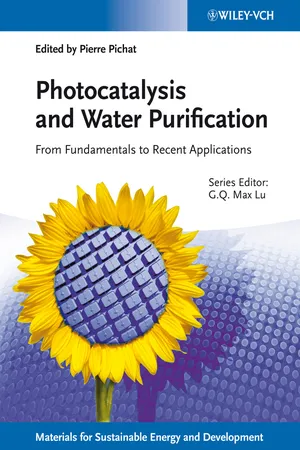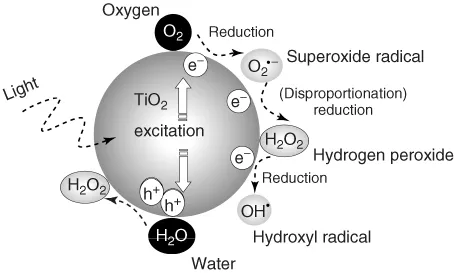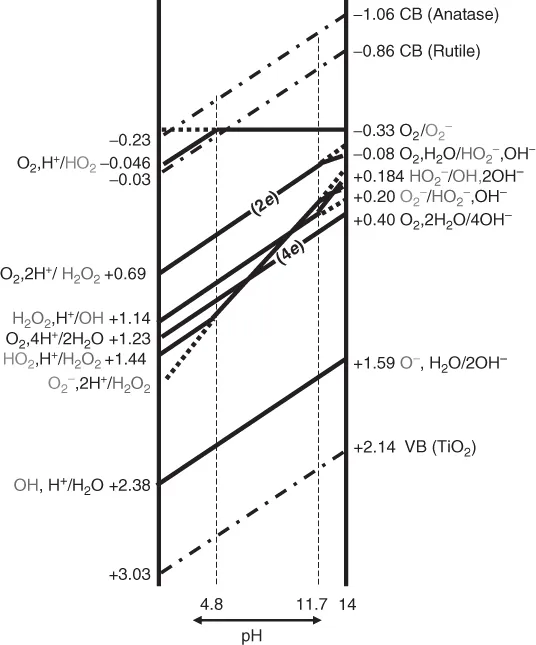![]()
Part I
Fundamentals: Active Species, Mechanisms, Reaction Pathways
![]()
1
Identification and Roles of the Active Species Generated on Various Photocatalysts
Yoshio Nosaka and Atsuko Y. Nosaka
TiO2 photocatalysts have been utilized for the oxidation of organic pollutants [1–5]. For further practical applications, the improvement in the photocatalytic efficiency and the extension of the effective wavelength of the irradiation light are desired. From this point of view, better understanding of the primary steps in photocatalytic reactions is prerequisite to develop prominent photocatalysts. The properties of TiO2 and the reaction mechanisms in molecular level have been reviewed recently [6]. Therefore, this chapter describes briefly active species involved in the photocatalytic reactions for bare TiO2 and TiO2 modified for visible-light response, that is, trapped electrons, superoxide radical (O2⋅−), hydroxyl radical (OH⋅), hydrogen peroxide (H2O2), and singlet oxygen (1O2).
1.1 Key Species in Photocatalytic Reactions
Since the photocatalytic reactions proceed usually with oxygen molecules (O2) in air, the reduction of oxygen would be the important process in photocatalytic reduction. On the other hand, taking into account that the surface of TiO2 photocatalysts is covered with adsorbed water molecules in usual environments and that photocatalysts are often used to decompose pollutants in water, oxidation of water would be the important process in photocatalytic oxidation. As shown in Figure 1.1, when O2 is reduced by one electron (Eq. (1.1)), it becomes a superoxide radical (O2⋅−) that is further reduced by one electron (Eq. (1.2)) or reacts with a hydroperoxyl radical (HO2⋅, i.e., protonated O2⋅−) to form hydrogen peroxide (H2O2). The latter reaction is largely pH dependent because the amount of HO2⋅, whose pKa is 4.8, changes largely at pH around neutral [7]. One-electron reduction of H2O2 (Eq. (1.3)) produces hydroxyl radical (OH⋅). In the field of radiation chemistry, it is well documented that OH⋅ is produced by one-electron oxidation of H2O with ionization radiation. However, the formation of OH⋅ in the photocatalytic oxidation process has not been confirmed, as described later.
Figure 1.2 shows the standard potentials [8] for the one-electron redox of active oxygen species as a function of pH of the solution. The conduction band (CB) bottom for anatase and rutile TiO2 along with valence band (VB) top of TiO2 is also depicted. The pKa values for H2O2 and OH⋅ are 11.7 and 11.9, respectively [7]. Therefore, the linear lines showing pH dependence in Figure 1.2 change the inclination at the individual pH. It is notable that in the pH range between 10.6 and 12.3, one-electron reduction resulting in OH⋅ formation (Eq. (1.3)) occurs at a higher potential than that resulting in H2O2 formation (Eq. (1.2)). As commonly known, the potential of the VB of TiO2 is low enough to oxidize H2O, suggesting the possibility of the formation of OH⋅. However, the potentials in the figure are depicted based on the free energy change in a homogeneous aqueous solution. Therefore, it does not always mean that the one-electron oxidation of H2O by VB holes at the surface of TiO2 solid takes place in the heterogeneous system. Since the oxidation of H2O to H2O2 and O2 is also possible, only the potential difference between VB and OH⋅ should not be used easily for explaining the possibility of the formation of OH⋅. The competition between OH-radical-mediated reaction versus direct electron transfer has been studied as the effect of fluoride ions on the photocatalytic degradation of phenol in an aqueous TiO2 suspension [9]. Under a helium atmosphere and in the presence of fluoride ions, phenol is significantly degraded, suggesting the occurrence of a photocatalytically induced hydrolysis [9].
Primary intermediates of water photocatalytic oxidation at the TiO2 in aqueous solution were investigated by in situ multiple internal reflection infrared (MIRIR) absorption combined with the observation of photoluminescence from trapped holes [10]. The reaction is initiated by a nucleophilic attack of a H2O molecule on a photogenerated hole at a surface two hold coordinated O site to form [TiO⋅HO–Ti]. A plausible reaction scheme is shown in Figure 1.3. Detailed investigations revealed the presence of TiOOH and TiOOTi as primary intermediates of the oxygen photoevolution reaction. This means that water is oxidized to form hydrogen peroxide adsorbed on TiO2 surface, but the formation of OH radical in the oxidation process of water was denied.
Ultraviolet photoelectron spectroscopy (UPS) studies showed that the top of the O-2p levels for surface hydroxyl groups (Ti–OH) at the rutile TiO2 (100) face is about 1.8 eV below the top of the VB at the surface [11]. This implies that surface hydroxyl groups cannot be oxidized by photogenerated holes in the VB. On the basis of the electronic structure of surface-bound water obtained from the data reported in the literature of X-ray photoelectron spectroscopy (XPS) study, it is evidenced that water species specifically adsorbed on terminal (surface) Ti atoms cannot be photooxidized under UV illumination [12]. The photogenerated VB free holes are favorably trapped at the terminal oxygen ions of the TiO2 surface (O2−)s to generate terminal (O−)s radicals, rather than being trapped at adsorbed water species to produce adsorbed OH⋅. As discussed later, when OH⋅ is detected in photocatalytic reactions, it should be formed by photocatalytic reduction of H2O2 (Eq. (1.3)).
1.2 Trapped Electron and Hole
Different from the semiconductor bulk, many electronic energy states may be formed within the band gap at the solid surface. These energy levels are capable of trapping VB holes and CB electrons. The trapped energy is considerably larger at the surface than in the bulk, indicating that it is energetically favorable for carriers to travel from the bulk to the surface [13]. At the surface, the trapping sites generally correspond to five-coordinated Ti+ and two-coordinated O− surface ions. When an appropriate acceptor (a scavenger), such as O2 for electrons or methanol for holes, is adsorbed on the surface, it was suggested that the carriers should be preferentially transferred to the adsorbate rather than remain trapped at the surface sites [13].
When there are no molecules that can suffer the reaction, the existence of electrons and holes can be detected at a low temperature such as 77 K. To detect such paramagnetic species, electron spin resonance (ESR) spectroscopy is a valuable method [14, 15].
Holes and electrons could be observed by the absorption spectra just after the short pulse excitation under ambient temperature [16]. Trapped holes show that the absorption peaked at about 500 nm [17] and disappeared by the further reactions. On the other hand, trapped electrons show a broad absorption band that peaked at about 700 nm [18], which react mainly with oxygen molecules in air. Trapped electrons are so stable in the absence of O2 that the kinetics can be explored by means of a stopped flow technique [19]. The reduction kinetics has been investigated through the electron acceptors such as O2, H2O2, and NO3−, which are often present in photocatalytic systems. The experimental results clearly showed that the stored electrons reduce O2 and H2O2 to water by multielectron transfer processes [19]. Moreover, NO3− is reduced via the transfer of eight electrons evidencing the formation of ammonium ions. On the other hand, in the reduction of toxic metal ions, such as Cu(II), two-electron transfer occurs, indicating the reduction of the copper metal ion into its nontoxic metallic form.
1.3 Superoxide Radical and Hydrogen Peroxide (O2⋅− and H2O2)
Si...






